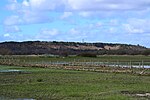Moorlands College
Moorlands College is an Evangelical Christian training college with a campus based in Sopley (near Christchurch) Dorset, and Regional Centres in Devon, and Belfast in Northern Ireland. All degree courses (including undergraduate and postgraduate degrees) are validated by the University of Gloucestershire. The college is non-denominational and acclaims a Statement of Faith which is shared by several Evangelical Christian organisations. The college participates in the Government’s Teaching Excellence Framework (TEF) and received a Silver TEF award in 2018. They are reviewed by the Quality Assurance Agency to ensure they fully meet national expectations as a provider of higher education.
Excerpt from the Wikipedia article Moorlands College (License: CC BY-SA 3.0, Authors).Moorlands College
Salisbury Road, New Forest Sopley
Geographical coordinates (GPS) Address External links Nearby Places Show on map
Geographical coordinates (GPS)
| Latitude | Longitude |
|---|---|
| N 50.7692 ° | E -1.7749 ° |
Address
Moorlands College
Salisbury Road
BH23 7AT New Forest, Sopley
England, United Kingdom
Open on Google Maps









